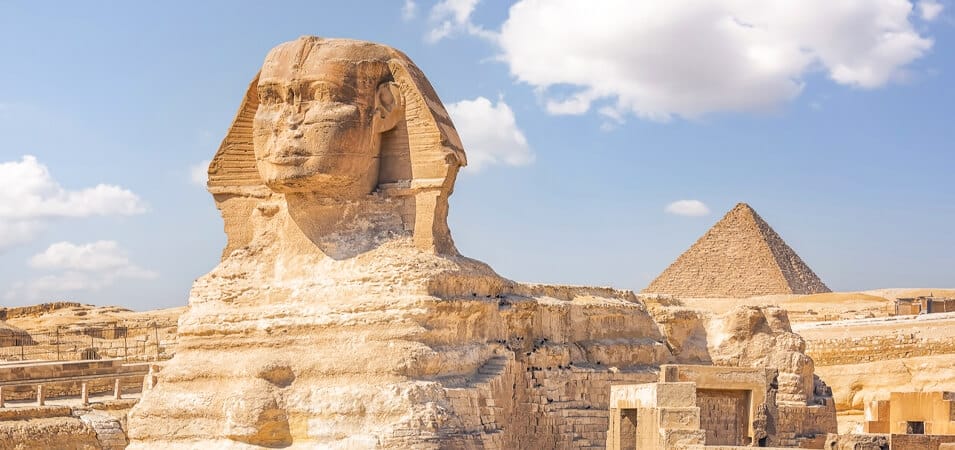Have you ever wondered about the secrets hidden within the sands of time? The Great Sphinx, an iconic structure standing tall in the heart of Egypt, beckons curious minds to explore its mysteries. This majestic monument, with the body of a lion and the head of a human, has captivated archaeologists, historians, and tourists alike for centuries. This article will delve into the fascinating history, construction, symbolism, and legends surrounding the Sphinx, illuminating this enigmatic marvel of ancient Egypt.
The Origins of the Sphinx

Ancient Egyptian Civilization: To understand the significance of the Sphinx, we must delve into the extraordinary world of ancient Egypt. The civilization that thrived along the banks of the Nile River left behind a rich legacy of art, architecture, and religious beliefs.
The Sphinx’s Construction: The Sphinx is believed to have been constructed during the reign of Pharaoh Khafre in the Old Kingdom period, around 2500 BCE. Skilled artisans meticulously carved the statue from a limestone outcrop, shaping it into a mythical creature with a lion’s body and a pharaoh’s face.
Theories on the Sphinx’s Purpose: Scholars and archaeologists have put forth various theories regarding the purpose of the Sphinx. Some suggest that it was a guardian figure, protecting the nearby pyramids and temples. Others propose that it held religious or astronomical significance, representing the sun god or the cycle of life and death.
Don’t Miss To Check Out OurEgypt Travel Packages
The Magnificence of the Great Sphinx
Monumental Architecture: Standing at a height of 66 feet (20 meters) and measuring 240 feet (73 meters), the Sphinx commands attention with its sheer size and scale. The precision with which it was carved reflects the exceptional architectural skills of the ancient Egyptians.
Iconic Features: Combining a lion’s body and a human head evokes a sense of power, wisdom, and authority. The human face, believed to be a depiction of Pharaoh Khafre, adds a personal touch to this awe-inspiring monument.
Symbolism and Cultural Significance: The Sphinx symbolizes the unity of the divine and royal authority in ancient Egypt. It embodies the concept of duality, representing the balance between the physical and spiritual realms and the harmony between humans and the gods.
Legends and Mysteries Surrounding the Great Sphinx

The Riddle of the Sphinx: In Greek mythology, the Sphinx posed a riddle to those who wished to pass by. Solving the puzzle was crucial to survival, as failure resulted in being devoured. The secret, “What creature walks on four legs in the morning, two legs at noon, and three legs in the evening?” remains one of the most famous riddles ever.
Connection to Pharaohs and Gods: According to Egyptian beliefs, the Sphinx was associated with the pharaoh’s divine kingship. It represented the ruler’s authority and connection to the gods, ensuring the prosperity and protection of the kingdom.
Secret Chambers and Hidden Treasures: Legends and tales abound about secret chambers and hidden treasures buried beneath the Sphinx. These stories have sparked the imagination of explorers and treasure hunters, leading to numerous expeditions and excavations around the monument.
Preservation Efforts and Restoration Projects
Challenges Faced by the Sphinx: Over the centuries, the Sphinx has endured natural erosion, human-induced damage, and environmental factors. Sandstorms, pollution, and urban development pose ongoing threats to its preservation.
Conservation Initiatives: Recognizing the historical and cultural significance of the Great Sphinx, conservation efforts have been undertaken to safeguard this iconic structure. Restoration projects have preserved its integrity, including cleaning, stabilizing the limestone, and protecting against further erosion.
Modern Techniques and Technologies: Advancements in technology, such as 3D scanning, laser mapping, and virtual reconstructions, have aided in the documentation and study of the Sphinx. These tools allow researchers better to analyze the monument’s construction techniques and historical context.
The Sphinx’s Influence on Art, Literature, and Pop Culture

Ancient Egyptian Art and Sculpture: The Sphinx has been an enduring source of inspiration for artists throughout history. Its representation can be seen in ancient Egyptian reliefs, paintings, and sculptures, showcasing its profound impact on the artistic expressions of the time.
Inspirations in Literature and Film: The Sphinx has continued to captivate storytellers worldwide, from ancient mythologies to contemporary novels and movies. Enigmatic allure and rich symbolism have found their way into numerous literature and cinematic masterpieces.
Tourist Attractions and Global Fascination: As one of Egypt’s most iconic landmarks, the Sphinx attracts millions annually. Its massive presence, combined with the aura of mystery surrounding it, makes it an irresistible destination for travelers seeking to witness the wonders of the ancient world.
Conclusion
The Great Sphinx is an extraordinary testament to the achievements and ingenuity of ancient Egypt. From its construction in antiquity to its enduring symbolism and allure, this enigmatic monument continues to captivate and intrigue. As we unravel the secrets of the Sphinx, we appreciate the remarkable legacy left by the ancient Egyptians and the profound impact their civilization has had on our understanding of history and human achievements. So, next time you gaze upon the Sphinx, let your imagination soar and ponder the mysteries within its majestic presence.
Don’t Miss To Read Out Our Related Article:
